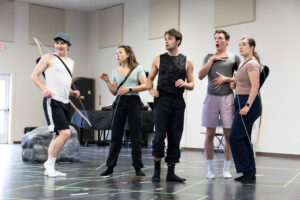Last week, we announced this season’s studio of Resident Artists. We also coined a new name for the program as we did so, reflecting how their role at the Festival has changed over the years. (Like Prince, they will likely become “the artists formerly known as Young Artists” for at least a season, while we all get used to the change.)

Lauren, Kelley, and Jay also joined me for inspiring days at the rehearsal hall, hearing the incredible talent that already exists in our local communities — and putting us a step closer to finishing up our casting for the season. We are still looking to fill a few remaining community chorus positions for this summer, so if you know any talented guys who might enjoy singing in the Tosca chorus, please send them our way. Imagine performing that powerful “Te Deum” alongside the great Greer Grimsley!
FrOM YAAp to RAP

Our commitment to our Resident Artists is a fundamental pillar of our mission. Since our first formal training program began in 1988 (then called the Glimmerglass Young American Artists), our Resident Artists have grown and evolved.
They have gradually taken on more supporting and comprimario roles in our productions; we have added pianists, coaches, conductors, and directors to the program; most recently, the collaborations we have forged with Ithaca College, Syracuse University, and other great institutions to add brilliant musical theater performers and dancers to the group have pushed the ensemble to new heights of versatility and achievement.


Our programming has expanded over the years to include great works of American musical theater as well as covering the entire 400+ years of the operatic canon; this summer, we will present the most modern musical we have attempted to date, again pushing our limits in that repertoire (Sunday dates from 1984). TV, movies, and the internet have led us to demand new levels of dramatic and physical realism onstage as well as on-screen. Contemporary opera now draws on a hitherto unimaginable range of styles and influences — composers often rely on musical eclecticism and polystylism (like that we will find in The House on Mango Street this summer) as they respond to today’s “Information Age.” Who knows what new demands we will place on our performers as technologies like virtual reality and AI become a regular part of our practice?
All these changes have required more stylistic flexibility and awareness from our artists than ever before: on any given day, they could be discussing details of Baroque ornamentation in the morning, reading through a new work’s gospel number in the afternoon, and find themselves performing a big dance number that evening — all in three or more languages. Talk about switch-hitters!
More Artists, Fewer Opportunities
Miraculously, our schools and conservatories are pouring out more versatile, capable, and prepared artists every single year — our application numbers are ever increasing. Yet it is also an unfortunate fact that the live performing arts sector has contracted over the same period, and there are far fewer opportunities awaiting these bright-eyed hopefuls than there were fifty years ago. Many artists spend several years after college working multiple side gigs to support themselves, seeking valuable performing experience wherever they can find it. Only a very fortunate (and brilliantly talented) few will achieve the dream of being able to fully support themselves through their art.

Our program has evolved to help fill that need — our Resident Artists today are a more diverse group in every respect, and many are already quite experienced professionals. Anyone who attends our performances witnesses their breathtaking talent and energy first-hand — and the sheer joy they derive from doing what they love. While you’re on campus this summer, please engage with them while they’re not rehearsing and performing and ask them about their lives, perhaps at one of our dinners, picnics, brunches, or lunchtime concerts — you are sure to be inspired by the drive and dedication they all share.

With the help of our “Destined to Glimmerglass” campaign, we will soon be unveiling new plans to ensure that we continue to provide a complete career ladder for the next generation. Through your support of our campaign, through your contributions to our gala, and through the sponsorships you provide each season, you directly impact not only their careers, but the entire performing arts ecosystem. Some of our patrons have remained in contact with the artists long after the summer, following their future trajectories and enjoying lifelong friendships. Why not consider sponsoring an artist yourself? We promise it will transform your understanding of what truly goes into “The Art of Making Art.”

